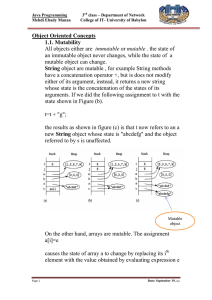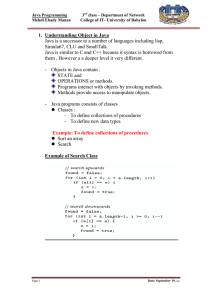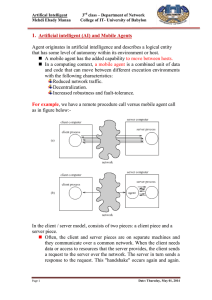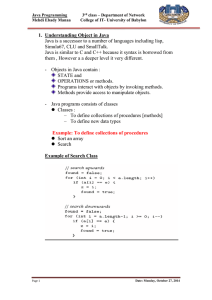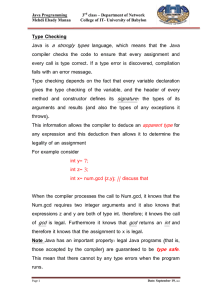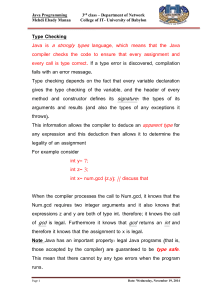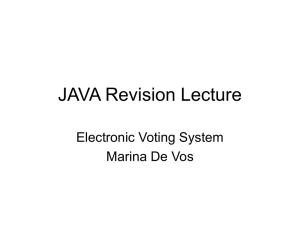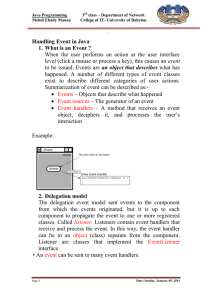Java Programming class – Department of Network
advertisement
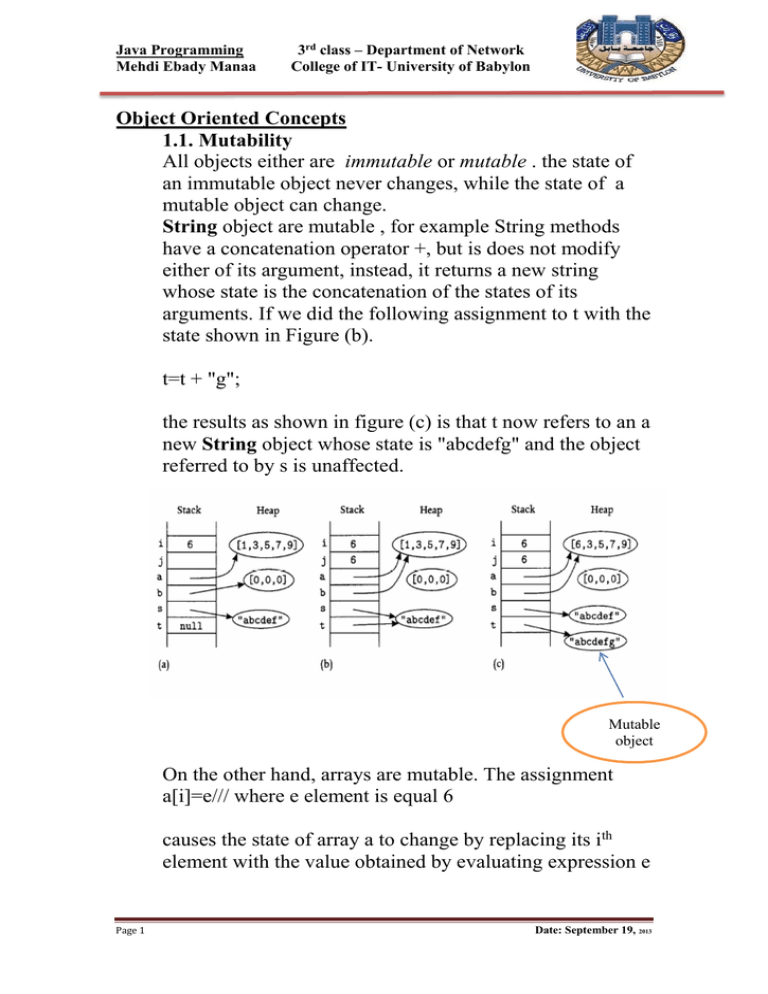
Java Programming
Mehdi Ebady Manaa
3rd class – Department of Network
College of IT- University of Babylon
Object Oriented Concepts
1.1. Mutability
All objects either are immutable or mutable . the state of
an immutable object never changes, while the state of a
mutable object can change.
String object are mutable , for example String methods
have a concatenation operator +, but is does not modify
either of its argument, instead, it returns a new string
whose state is the concatenation of the states of its
arguments. If we did the following assignment to t with the
state shown in Figure (b).
t=t + "g";
the results as shown in figure (c) is that t now refers to an a
new String object whose state is "abcdefg" and the object
referred to by s is unaffected.
Mutable
object
On the other hand, arrays are mutable. The assignment
a[i]=e/// where e element is equal 6
causes the state of array a to change by replacing its ith
element with the value obtained by evaluating expression e
Page 1
Date: September 19, 2013
Java Programming
Mehdi Ebady Manaa
3rd class – Department of Network
College of IT- University of Babylon
( the modification occurs only if i is in bounds for a, an
exception is thrown otherwise).
Discussion Note
If a mutable object is shared by two or more variables,
modifications made through one of the variables will be
visible when the object is used through the other variable.
Example
Suppose the shared array in figure (b) is modified by
b[0]=i; // i= 6 before
this causes the zeroth element of the array to contain 6
( instead of 1 it used to contain ) , as shown in figure
(c)
1.2. Method Call Semantic
An attempt to call a method as in this form :
e. m (), // where e is a representative of a class and m
is a method
first evaluates e to obtain the class of object whose
method is being called .
Then the expression for the arguments are evaluated
to obtain actual parameter values المتغيرات الفعلية. This
evaluation happen left to right.
Page 2
Date: September 19, 2013
Mutable
object
Java Programming
Mehdi Ebady Manaa
3rd class – Department of Network
College of IT- University of Babylon
Next an activation record is created for the call and
pushed onto the stack; the activation record contains
room for the formal parameters المعامالت الشكليةof the
method ( the formals are the variables declared in the
method header) and any other local storage the
method required.
When the actual parameter are assigned to the
formals , this kind of parameters passing is called
"call by value" and
Finally control is dispatched to the called method
e.m.
Note: if the actual parameters value is a reference to
an object, that reference is assigned to the formal .
this means that the called procedure shares object
with its caller. Furthermore, if these object are
mutable, and the called procedure change their state,
these changes are visible to the caller when it returns.
Example
And in the main class, we define
And we call the method
Page 3
Date: September 19, 2013
Java Programming
Mehdi Ebady Manaa
3rd class – Department of Network
College of IT- University of Babylon
The results in the Stack storage are:
Method Call
After return
form
Method
Example 2
Page 4
Date: September 19, 2013
Java Programming
Mehdi Ebady Manaa
3rd class – Department of Network
College of IT- University of Babylon
Example 2
public class CallsByRefers {
/**
* @param args
*/
public static void main(String[] args) {
// TODO Auto-generated method stub
CallsByRefers cc=new CallsByRefers();
int [] b= {0,2,3,4};
int kl=9;
cc.change(b, kl);
for (int o=0; o<b.length;o++)
{
System.out.println(b[o]);
}
System.out.println("The Value of kl after return from
method "+kl);
}
public int change (int [] a, int j){
Page 5
Date: September 19, 2013
Java Programming
Mehdi Ebady Manaa
3rd class – Department of Network
College of IT- University of Babylon
int i = j*2;
System.out.println("The value of i inside the methdo
"+i);
for (int k=0; k<a.length;k++)
{
a[k]=a[k]*2;
}
return j;
}// End Main Method
}// End CallsByRefers Class
The Output for Example 2 is :The value of i inside the method 18
0
4
6
8
The Value of kl after return from method 9
Quiz #1
Page 6
Date: September 19, 2013
